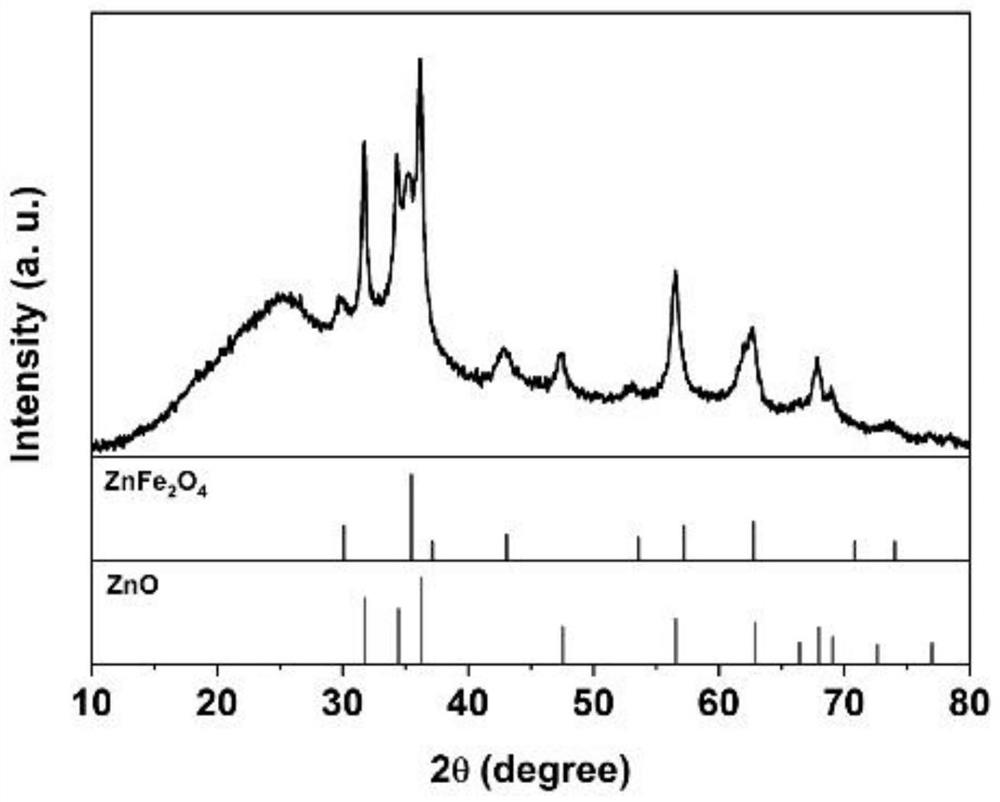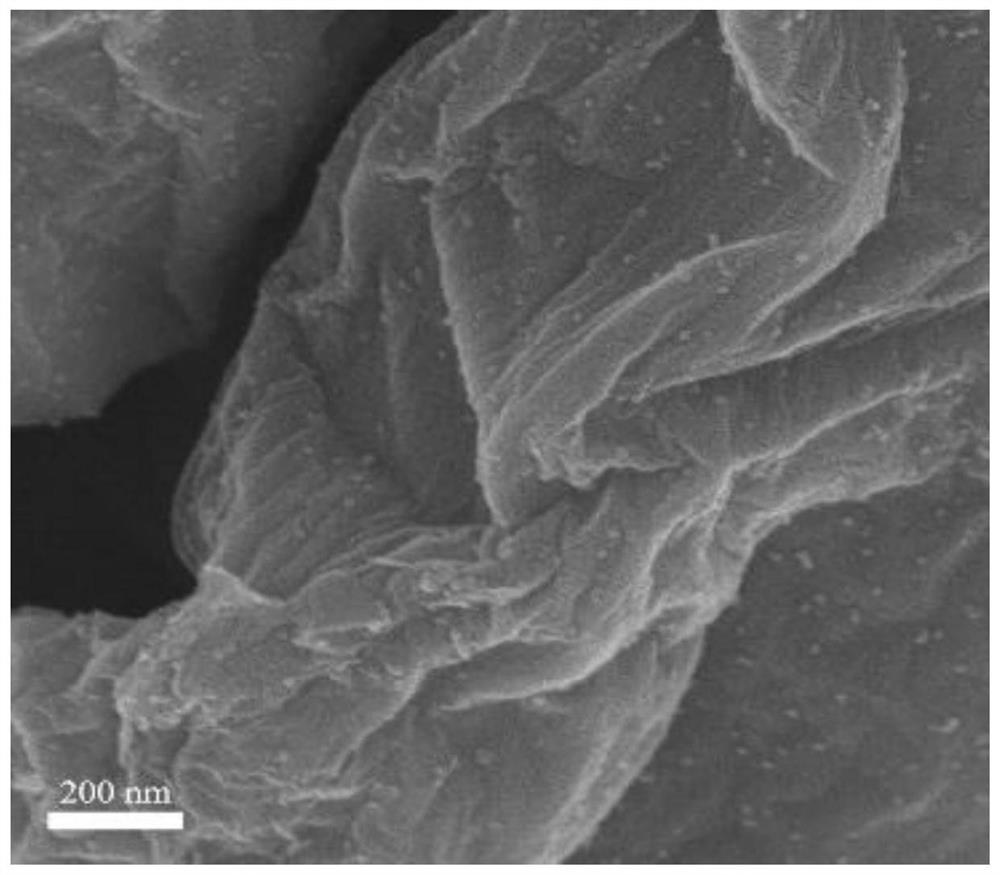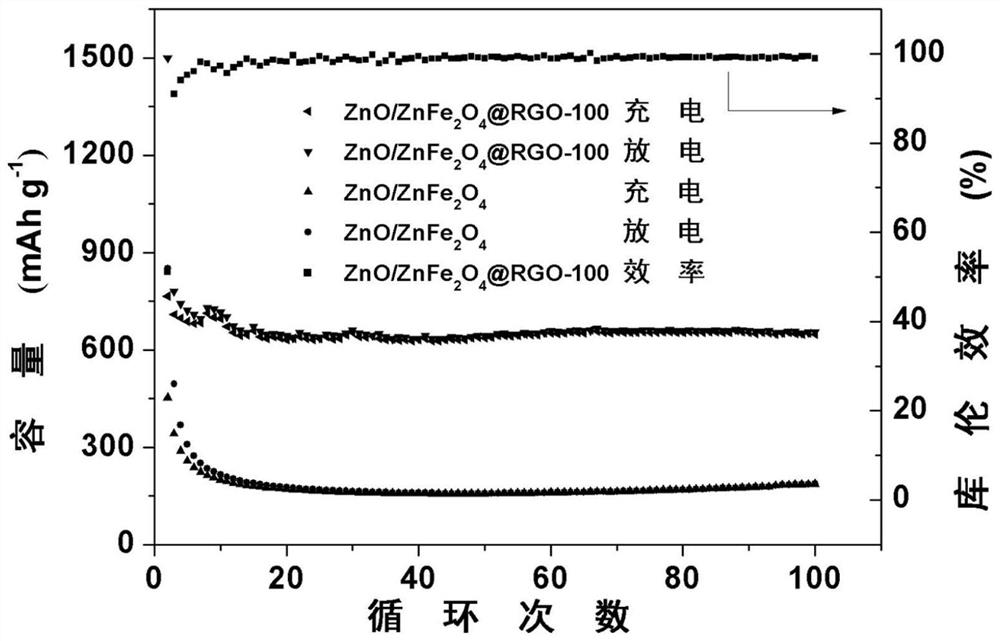Graphene-zinc-based oxide composite material, preparation method thereof and application of graphene-zinc-based oxide composite material in lithium ion battery negative electrode material
A composite material, graphene technology, applied in the field of lithium-ion batteries, can solve the problems of electrode crushing capacity, attenuation, poor conductivity, etc.
- Summary
- Abstract
- Description
- Claims
- Application Information
AI Technical Summary
Problems solved by technology
Method used
Image
Examples
preparation example Construction
[0027] The present invention also provides a method for preparing the graphene-zinc-based oxide composite material described in the above technical solution, comprising the following steps:
[0028] mixing graphene oxide with an organic solvent to obtain a graphene oxide dispersion;
[0029] Mixing the graphene oxide dispersion, zinc source, iron source and organic ligands, performing a hydrothermal reaction to obtain a composite material precursor;
[0030] The composite material precursor is calcined to obtain a graphene-zinc-based oxide composite material.
[0031] The invention adopts a hydrothermal-high-temperature solid-phase method to prepare graphene-zinc-based oxide composite materials, the preparation process is simple and convenient, and it is suitable for popularization and application.
[0032] The invention mixes the graphene oxide and the organic solvent to obtain the graphene oxide dispersion liquid. In the present invention, the organic solvent is preferably...
Embodiment 1
[0044] Preparation of graphene-zinc-based oxide composite ZnO / ZnFe by hydrothermal method-high temperature solid state method 2 o 4 @RGO-100 nanocomposite material: Among them, 100 represents the addition of 100mg graphene oxide in hydrothermal reaction;
[0045] Disperse 0.1g of graphene oxide in a mixed solution of 100mL N,N-dimethylformamide and ethanol by ultrasonic cell disruption, wherein the volume ratio of N,N-dimethylformamide and ethanol is 5:3, to obtain Graphene oxide dispersion;
[0046] 0.63mmol Zn(NO 3 ) 2 ·6H 2 O, 0.68mmol iron acetylacetonate and 0.23mmol terephthalic acid were added to the graphene oxide dispersion, and transferred to an autoclave lined with Teflon, heated to 100°C, and hydrothermally reacted for 6 hours; the resulting system Wash the centrifuge with N,N-dimethylformamide and ethanol in sequence, and dry the solid material obtained by centrifugation at 80°C overnight;
[0047] The composite material precursor was placed in a calciner, a...
Embodiment 2
[0050] Preparation of graphene-zinc-based oxide composite ZnO / ZnFe by hydrothermal method-high temperature solid state method 2 o 4 @RGO-50 nanocomposite material: Among them, 50 represents hydrothermal reaction adding 50mg graphene oxide)
[0051] Disperse 0.05g graphene oxide in a mixed solution of 100mL N,N-dimethylformamide and ethanol by ultrasonic cell disruption, wherein the volume ratio of N,N-dimethylformamide and ethanol is 5:3, to obtain Graphene oxide dispersion;
[0052] 0.63mmol Zn(NO 3 ) 2 ·6H 2 O, 0.68mmol iron acetylacetonate and 0.23mmol terephthalic acid were added to the graphene oxide dispersion, and transferred to an autoclave lined with Teflon, heated to 100°C, and hydrothermally reacted for 6 hours; the resulting system Centrifuge with N,N-dimethylformamide and ethanol in turn, and dry the solid material obtained by centrifugation at 80°C overnight to obtain a composite material precursor;
[0053] The composite material precursor was placed in a ...
PUM
| Property | Measurement | Unit |
|---|---|---|
| The average particle size | aaaaa | aaaaa |
Abstract
Description
Claims
Application Information
 Login to View More
Login to View More - R&D
- Intellectual Property
- Life Sciences
- Materials
- Tech Scout
- Unparalleled Data Quality
- Higher Quality Content
- 60% Fewer Hallucinations
Browse by: Latest US Patents, China's latest patents, Technical Efficacy Thesaurus, Application Domain, Technology Topic, Popular Technical Reports.
© 2025 PatSnap. All rights reserved.Legal|Privacy policy|Modern Slavery Act Transparency Statement|Sitemap|About US| Contact US: help@patsnap.com



